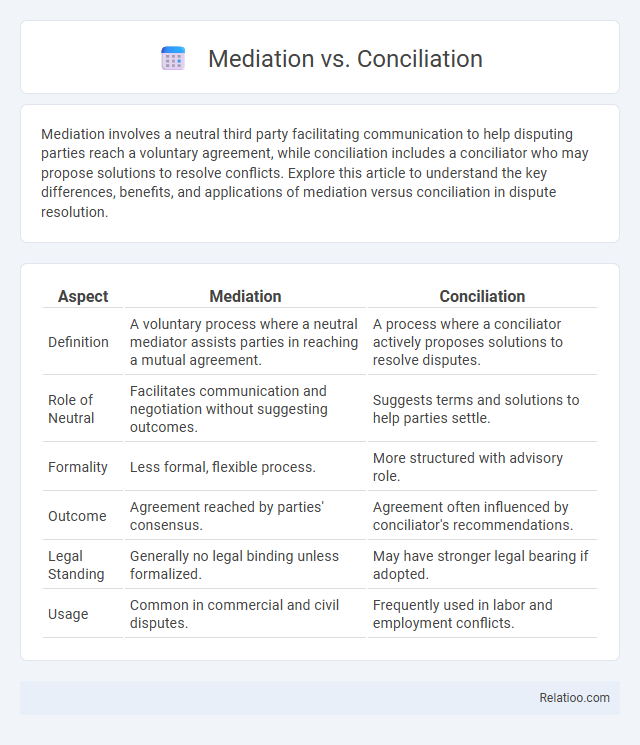Mediation involves a neutral third party facilitating communication to help disputing parties reach a voluntary agreement, while conciliation includes a conciliator who may propose solutions to resolve conflicts. Explore this article to understand the key differences, benefits, and applications of mediation versus conciliation in dispute resolution.
Table of Comparison
| Aspect | Mediation | Conciliation |
|---|---|---|
| Definition | A voluntary process where a neutral mediator assists parties in reaching a mutual agreement. | A process where a conciliator actively proposes solutions to resolve disputes. |
| Role of Neutral | Facilitates communication and negotiation without suggesting outcomes. | Suggests terms and solutions to help parties settle. |
| Formality | Less formal, flexible process. | More structured with advisory role. |
| Outcome | Agreement reached by parties' consensus. | Agreement often influenced by conciliator's recommendations. |
| Legal Standing | Generally no legal binding unless formalized. | May have stronger legal bearing if adopted. |
| Usage | Common in commercial and civil disputes. | Frequently used in labor and employment conflicts. |
Understanding Mediation and Conciliation
Understanding mediation involves a neutral third party helping disputing parties reach a voluntary, mutually acceptable agreement, focusing on open communication and collaboration. Conciliation, distinct from mediation, includes the conciliator actively suggesting solutions and improving relationships, often guiding parties toward resolving misunderstandings. Your choice between mediation and conciliation depends on whether you prefer a facilitative approach that encourages dialogue or a more advisory process that offers concrete recommendations.
Key Differences Between Mediation and Conciliation
Mediation involves a neutral third party facilitating communication between disputing parties to help them reach a mutually acceptable agreement, while conciliation includes the conciliator actively proposing solutions and providing suggestions to resolve the dispute. You should know that mediation is more about guiding dialogue, whereas conciliation focuses on advising and settlement proposals tailored to the conflict context. Understanding these distinctions helps in selecting the appropriate dispute resolution method based on the level of intervention and control you desire in resolving your issues.
Legal Frameworks Governing Mediation and Conciliation
Mediation and conciliation are alternative dispute resolution methods governed by distinct legal frameworks that emphasize confidentiality, neutrality, and voluntary participation. Legal statutes like the Uniform Mediation Act (UMA) and the Model Conciliation Act regulate procedural rules, enforceability of settlements, and mediator qualifications, directly impacting how your agreement is formalized and enforced. Understanding your rights within these frameworks helps ensure informed decisions during dispute resolution, offering a legally recognized pathway to settle conflicts outside traditional litigation.
Role of the Mediator vs the Conciliator
The role of the mediator centers on facilitating communication and negotiation between disputing parties without imposing solutions, aiming to help them reach a mutually acceptable agreement. In contrast, the conciliator takes a more active role by suggesting terms of settlement and offering expert advice to guide parties toward resolution. Both methods prioritize confidentiality and voluntary participation, but mediation relies more on neutrality, while conciliation involves a more directive approach by the conciliator.
Process Flow: Mediation Step-by-Step
Mediation involves a neutral mediator guiding disputing parties through a structured step-by-step process, including opening statements, issue identification, private caucuses, negotiation, and final agreement drafting. Conciliation, while similar, emphasizes restoring relationships with a conciliator offering solutions and less formal intervention. Understanding these distinctions helps you navigate conflict resolution effectively by selecting the most suitable process flow for your dispute.
Process Flow: Conciliation Step-by-Step
Conciliation involves a structured process where a neutral conciliator facilitates communication between disputing parties to identify issues and explore mutually acceptable solutions. The step-by-step flow begins with the conciliator meeting both parties separately to understand their perspectives, followed by joint sessions encouraging dialogue and compromise. The process concludes with drafting a voluntary agreement that resolves the conflict, emphasizing collaboration without formal adjudication.
Benefits of Choosing Mediation
Mediation offers a confidential and flexible process that empowers parties to collaboratively resolve disputes without the need for formal litigation. The mediator facilitates open communication, promoting mutual understanding and preserving relationships while saving time and reducing costs. Compared to conciliation or arbitration, mediation provides greater control over outcomes and encourages win-win agreements tailored to the specific needs of the parties involved.
Advantages of Opting for Conciliation
Conciliation offers a flexible and confidential approach to dispute resolution that empowers You to maintain control over the outcome while avoiding the formality of court proceedings. Unlike mediation and arbitration, conciliation involves an impartial conciliator who actively assists parties in reaching a mutually acceptable agreement, enhancing the chances of a sustainable resolution. The cost-effectiveness and faster resolution timelines of conciliation make it a practical choice for resolving conflicts efficiently.
Case Studies: Mediation and Conciliation in Practice
Mediation and conciliation are alternative dispute resolution methods with distinct processes and outcomes, each demonstrated through various case studies showcasing their effectiveness in resolving conflicts outside of court. Mediation engages a neutral third party to facilitate communication and negotiation between disputing parties, often leading to mutually agreeable solutions, while conciliation involves a conciliator who actively proposes terms to settle the dispute, emphasizing restoration of relationships. Your understanding of these methods can be deepened by examining specific cases where mediation successfully resolved commercial disputes and conciliation restored workplace harmony, highlighting practical differences and benefits in real-world scenarios.
How to Choose Between Mediation and Conciliation
Choosing between mediation and conciliation depends on the nature of the dispute and the level of involvement you want from the neutral third party. In mediation, the mediator facilitates communication and helps parties reach a voluntary agreement, while in conciliation, the conciliator plays a more active role by proposing solutions and offering recommendations. Your choice should align with whether you prefer a cooperative dialogue or a more directive approach to find a resolution efficiently.

Infographic: Mediation vs Conciliation
 relatioo.com
relatioo.com